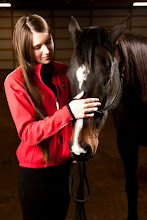Hello again,
The pursuit for lightness continues. Today, another sunny January day, Cody took his first steps forward! Once again, stop and go was the key to his forward motion. He loves 'whoa' and, for the first time, went forward in a long walk with light calf presure. Zigs is still plagued with some unknown affliction, but next Friday he sees a chiropractor. Even under an actual saddle he stayed upright, so the mystery continues. Mag had the day off due to time constraints caused from taking my sick father into town for lunch. My father, for those who don't know, was in the hospital after Christmas and has been recovering very slowly the last two weeks. Today, however, was the first trip into town where we did not have to rush home! Little steps, but they are steps. Dancer continues his pursuit for Stock Show.
To continue with history lessons, Cavendish and Gueriniere are tonight's topics. William Cavendish, the Duke of Newcastle, published "A General System of Horsemanship" in 1657, thirty-four years after Pluvinel's book was published. Cavendish was a strong proponent of manege riding, having built lavish riding halls for his own riding pursuits. He found influence from the philosophers Dryden, Descartes, and Hobbes. Cavendish knew his importance: "...if this work pleases you, I shall be thoroughly well satisfied; if not, I shall be content in my own mind; because I know certainly that it is very good, and better than any thing that you have had before of the kind" (quoted from "The Development of Modern Riding", Vladimir Littauer, pg. 48). In Cavendish's book, he has etchings showing him on a perfectly behaved stallion performing airs above the ground while other horses salute him. Unlike Pluvinel, Cavendish was more than just a nobleman, but also a duke and one of the wealthiest in England (Littauer, 49).
F.R. de la Gueriniere was a nobleman who published his book, "Ecole de Cavalerie", in 1733. He is the most recognized and widely accepted of the historical trainers. When one hears of Classical Dressage training now, it usually lies claim to Gueriniere's theories. Gueriniere continued the humanist movement in horsemanship and included bits of science. The mid-18th century was one of scientific experimentation and the development of what scientific experimentation was. "'Every science and every art possesses principles and rules by means of which discoveries are made which lead to its development...Practice, however, devoid of true principle is no more than routine, the results of which are a forced and uncertain execution...'" (Littauer, 45). It is also generally accepted that Gueriniere developed the shoulder-in as we use it today, on a straight line.
The most important thing to remember about Pluvinel, Cavendish, and Gueriniere is that they were the start of the humanist movement in horsemanship, meaning the trainer worked with the horse's natural tendencies rather than using force. This idea is the foundation of the natural horsemanship that is so popular right now. These trainers, however, did not allow the horse to move un-collected. The horse was always in a correct frame with a light mouth and shoulders. In their minds, art should improve on nature.
Tomorrow, we enter the era of the circus and insults with the once famous feud between Baucher and d'Aure.
Ciao (I know it's Italian, but I don't know French yet),
K.Moreaux
Thursday, January 14, 2010
Subscribe to:
Post Comments (Atom)

No comments:
Post a Comment